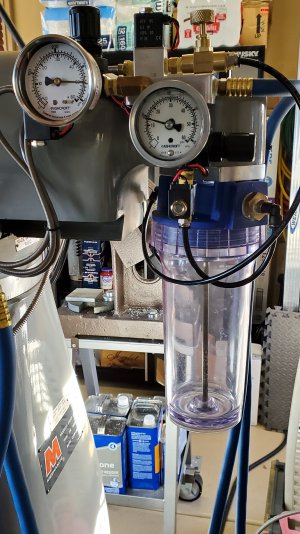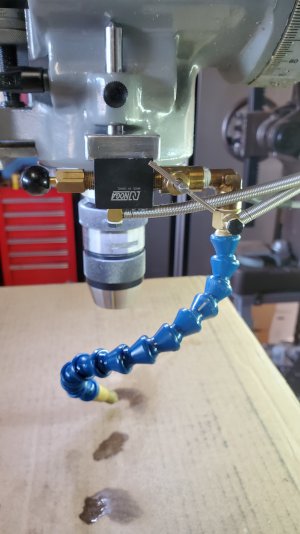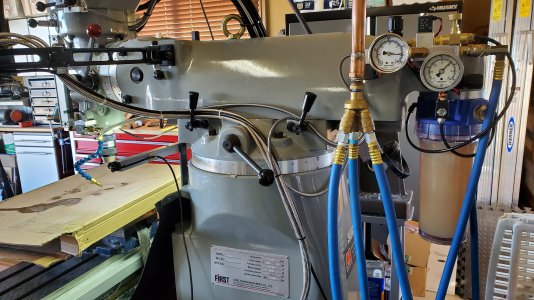- Joined
- Jun 12, 2014
- Messages
- 4,817
There have been a number of designs posted to decrease misting and promote more of a droplet deposition of coolant. I have had assorted parts that I have collected through the years to make a FogBuster type system, and finally got around to installing a system one my mill using readily available pneumatic parts. Major cost if buying new would be the coolant reservoir and purchasing something like a NOGA MC17001 coolant applicator, but there are less expensive versions that are available or you could make your own. I had a MC17001 which I removed the magnetic base and mounted the coolant applicator to my mill head. Different connectors and components can significantly vary the cost, I used what I had, but also put together a list of components and some sources. So more of a conceptual design, probably could have made it a bit prettier if I did not use parts that I had on hand.
The key to decreasing the misting effect is to use lower pressures with needle flow valves and pressurization of the fluid reservoir so coolant doesn't need to be sucked into the air stream. Using solenoids for both the air line and the coolant line allow them to be electronically turned on for air only, run with coolant or squirt coolant as needed. Placement of needle valves in each line control the individual flow in addition to the air pressure regulator pressure. So the idea is more using air volume at low pressure, with the option of coolant and balancing the pressure vs. needle valve. Pressure in the coolant circuit forces it to flow into the air stream, you will still have an issue with misting if you are running high air pressure and volume.
I mounted my coolant reservoir to the back of the mill and using two solenoid valves there is no risk of coolant leaking/dripping after the it is shut off. Since it is pressurized it can be mounted at any height. The coolant reservoir is a water filter housing with an added central brass tube connected to the outlet side so fluid is pushed into the outlet from the bottom. I had a block of aluminum and machined it into an air distribution manifold and also serves as a mount for the system to the back of my mill. I use a 1/4" pressure regulators followed by a solenoid valve for the air and coolant lines, the air solenoid connects to the Noga air line. The coolant side goes to pressurize the reservoir, which then goes to a control needle valve attached to another coolant solenoid, the outlet connects the coolant line to the Noga. This arrangement limits the pressure in the coolant tank, and also decrease dribble once the coolant is turned off. The needle valve as well as pressure in the tank effect the coolant flow. I have been running my coolant tank pressure about 10 PSI below my air line. The system works surprisingly well and pretty simple to put together.
On most of my control systems I use a coolant contactor/relay that turns on/off with the spindle rotation. I am using a 3 way rotary switch on my mill, so off is to the left, middle rotation activates the air solenoid and right rotation activates air/coolant solenoids. The Noga also has a on/off air switch in its manifold block and I added a needle valve to manifold to also adjust the air flow.
I am running KoolRite 2290 at a bit over 10% concentration. I started with higher pressures, but have dialed it down to 20 PSI on my air line and 10 PSI on the fluid line with the needle valves a bit more open. So much lower pressures than would be used in most air coolant systems. I get more of a spitting than misting as can be seen on the carboard wet spots. I noticed a significant improvement in milling aluminum and when drilling holes, haven't used it on steel yet.
Diagrams and parts list is in the attached file.



The key to decreasing the misting effect is to use lower pressures with needle flow valves and pressurization of the fluid reservoir so coolant doesn't need to be sucked into the air stream. Using solenoids for both the air line and the coolant line allow them to be electronically turned on for air only, run with coolant or squirt coolant as needed. Placement of needle valves in each line control the individual flow in addition to the air pressure regulator pressure. So the idea is more using air volume at low pressure, with the option of coolant and balancing the pressure vs. needle valve. Pressure in the coolant circuit forces it to flow into the air stream, you will still have an issue with misting if you are running high air pressure and volume.
I mounted my coolant reservoir to the back of the mill and using two solenoid valves there is no risk of coolant leaking/dripping after the it is shut off. Since it is pressurized it can be mounted at any height. The coolant reservoir is a water filter housing with an added central brass tube connected to the outlet side so fluid is pushed into the outlet from the bottom. I had a block of aluminum and machined it into an air distribution manifold and also serves as a mount for the system to the back of my mill. I use a 1/4" pressure regulators followed by a solenoid valve for the air and coolant lines, the air solenoid connects to the Noga air line. The coolant side goes to pressurize the reservoir, which then goes to a control needle valve attached to another coolant solenoid, the outlet connects the coolant line to the Noga. This arrangement limits the pressure in the coolant tank, and also decrease dribble once the coolant is turned off. The needle valve as well as pressure in the tank effect the coolant flow. I have been running my coolant tank pressure about 10 PSI below my air line. The system works surprisingly well and pretty simple to put together.
On most of my control systems I use a coolant contactor/relay that turns on/off with the spindle rotation. I am using a 3 way rotary switch on my mill, so off is to the left, middle rotation activates the air solenoid and right rotation activates air/coolant solenoids. The Noga also has a on/off air switch in its manifold block and I added a needle valve to manifold to also adjust the air flow.
I am running KoolRite 2290 at a bit over 10% concentration. I started with higher pressures, but have dialed it down to 20 PSI on my air line and 10 PSI on the fluid line with the needle valves a bit more open. So much lower pressures than would be used in most air coolant systems. I get more of a spitting than misting as can be seen on the carboard wet spots. I noticed a significant improvement in milling aluminum and when drilling holes, haven't used it on steel yet.
Diagrams and parts list is in the attached file.





